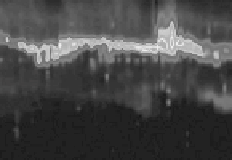Geoscience Reference
In-Depth Information
110
105
100
95
90
110
105
100
95
90
85
80
85
80
18
19
20
21
22
23
00
01
02
18
19
20
21 22
Local time (AST)
23
00
01
02
Local time (AST)
Electron density (/cc)
Measured sodium density (/cc)
5.0 3 10
4
1.0 3 10
5
1.5 3 10
5
0
0
3000
6000
9000
12000
(a)
(b)
Figure 6.7
Intense sporadic E event (a) measured by the Arecibo radar, accompanied
by release of sodium atoms detected by a sodium lidar (b). [After Swartz et al. (2002).
Reproduced with permission of the American Geophysical Union.] See Color Plate 11.
0
when expressed in Fourier form and holds for all the low frequency waves
considered here. This is the Boussinesq approximation, which uses
This equation is equivalent to the assumption of incompressible flow
∇·
U
=
∇·
U
=
0 for
wave perturbations when
ω<ω
b
but allows for compressibility in the zero-order
equations. Equation (6.11) can also be written
|
v
/
w
|=|
λ
/λ
|
y
z
w
. That is, the
horizontal component of the perturbation wind is much stronger than the ver-
tical, and we explore its effect on the plasma next.
An example of the plasma layering that occurs is presented in Fig. 6.7. Here the
Arecibo radar has been used in a high-resolution mode to best characterize these
thin layers. Interesting structures occur for many hours. Remarkably, the neutral
sodium atoms revealed by a sodium lidar also seem to be layered. At first this
is surprising, since the plasma layers only occur due to magnetic forces, which
do not affect the neutrals. However, recent advances in our understanding of
ion and neutral sodium chemistry seem capable of explaining these atom layers
(Cox and Plane, 1998; Swartz et al., 2002). We return to this topic later in this
section.
As a first study, consider the F-layer valley where
Typically,
λ
y
λ
z
for the periods of interest here, so
v
κ
i
is large. For a wave having
a small vertical wavelength, we have sketched the horizontal component of wind
fluctuations for a typical gravity wave as a function of height in Fig. 6.8. This
figure illustrates the case in which the perturbation wind lies in the magnetic
meridian and, as also shown, the magnetic field has a finite dip angle. Because the
plasma is constrained to move with the component of the neutral wind motion
parallel to
B
when
κ
i
is large, in regions where the perturbation wind changes















































































Search WWH ::

Custom Search